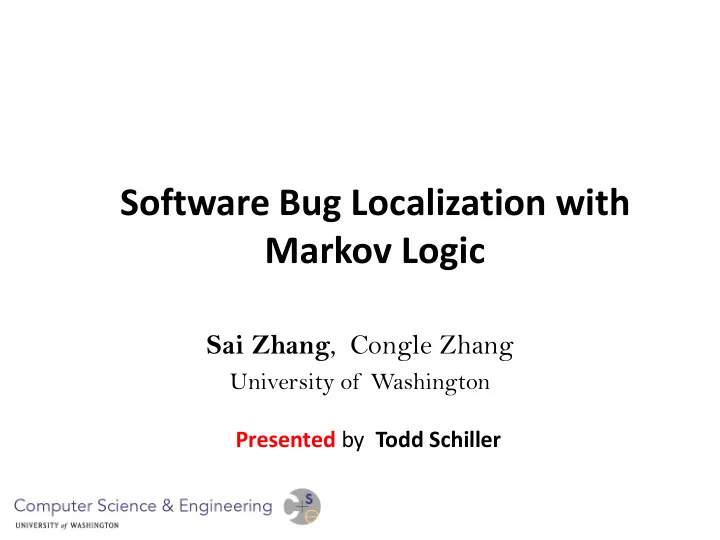

Software Bug Localization with Markov Logic Sai Zhang , Congle Zhang University of Washington Presented by Todd Schiller
Software bug localization: finding the likely buggy code fragments A software system Some observations (source code) (test results, code coverage, bug history, code dependencies, etc.) A ranked list of likely buggy code fragments
An example bug localization technique (Tarantula [ Jones’03 ]) • Input : a program + passing tests + failing tests • Output : a list of buggy statements 3. if (a >= b) { 4. return b; Tests 1. a = arg1 Example: arg1 = 2 2. b = arg2 arg1 = 2 arg1 = 1 arg2 = 1 arg2 = 2 arg2 = 2 5. } else { max(arg1, arg2) { 6. return a; 1. a = arg1 2. b = arg2 3. if (a b) { >= < 4. return b; 5. } else { 6. return a; 7. } }
Tarantula’s ranking heuristic For a statement: s %𝑔𝑏𝑗𝑚(𝑡) Suspiciousness(s) = %𝑔𝑏𝑗𝑚 𝑡 + %𝑞𝑏𝑡𝑡(𝑡) Percentage of failing tests Percentage of passing tests covering statement s covering statement s This heuristic is effective in practice [ Jones’05 ]
Problem: existing techniques lack an interface layer • Heuristics are hand crafted • Techniques are often defined in an ad-hoc way • A persistent problem in the research community Tarantula xDebug CBI Raul Wang Techniques … Liblit PLDI’05 ICSE’09 ICSE’09 Jones ICSE’03 Wong, Compsac’07 … Static Line Branch Def-use Observations Predicate … Code Info coverage coverage relations
Adding an interface layer Tarantula xDebug CBI Raul Wang Why an interface layer? … Liblit PLDI’05 ICSE’09 ICSE’09 Jones ICSE’03 Wong, Compsac’07 • Focus on key design insights • Avoid “magic numbers “ in heuristics Interface layer • Fair basis for comparison Static Line Branch Def-use • Predicate … Fast prototyping Code Info coverage coverage relations
Who should be the interface layer? Tarantula xDebug CBI Raul Wang … Liblit PLDI’05 ICSE’09 ICSE’09 Jones ICSE’03 Wong, Compsac’07 Static Line Branch Def-use Predicate … Code Info coverage coverage relations
Markov logic network as an interface layer Tarantula xDebug CBI Raul Wang … Liblit PLDI’05 ICSE’09 ICSE’09 Jones ICSE’03 Wong, Compsac’07 Markov Logic Network Static Line Branch Def-use Predicate … Code Info coverage coverage relations
Why Markov Logic Network [Richardson’05]? • Use first order logic to express key insights – E.g., estimate the likelihood of cancer(x) for people x Example rules: smoke(x) => cancer(x) smoke(x) ∧ friend(x,y) => smoke(y) friends(x, y) ∧ friends(y, z) => friends(x, z) smoke causes cancer you will smoke if your friend smokes friends of friends are friends
Why Markov Logic Network [Richardson’05]? • Use first order logic to express key insights – E.g., estimate the likelihood of cancer(x) for people x Example rules: smoke(x) => cancer(x) w1 smoke(x) ∧ friend(x,y) => smoke(y) w2 friends(x, y) ∧ friends(y, z) => friends(x, z) w3 • Efficient weight learning and inference – Learning rule weights from training data – Estimate cancer(x) for a new data point (details omitted here)
Markov logic for bug localization Training data First-order logic rules Alchemy (capture insights) (learning) Researchers A markov logic network engine Rule weights Alchemy Likelihood of s being buggy (inference) A statement: s
Markov logic for bug localization Different rules for Training data different bug localization algorithms First-order logic rules Alchemy (learning) Researchers A markov logic network engine Rule weights Alchemy Likelihood of s being buggy (inference) A statement: s
Our prototype: MLNDebugger • First-order rules 1. cover(test, s) ∧ fail(test) => buggy(s) 2. cover(test, s) ∧ pass(test) => ¬ buggy(s) 3. control_dep(s1, s2) ∧ buggy(s1) => ¬ buggy(s2) A statement covered by a 4. data_dep(s1, s2) ∧ buggy(s1) => ¬ buggy(s2) A statement covered by a failing test is buggy 5. wasBuggy(s) => buggy(s) passing test is not buggy If a statement has control Learning and inference If a statement has data flow dependence on a buggy v = foo() Buggy! dependence on a buggy A statement that was buggy statement, then it is not buggy A statement: Rules + Weights bar(v) Correct! statement, then it is not buggy stmt before is buggy if(foo(x)) { Buggy! Buggy! bar(); Correct! Correct! How likely stmt is buggy }
Evaluating MLNDebugger on 4 Siemens benchmarks • 80+ seeded bugs – 2/3 as training set – 1/3 as testing set • Measurement on the testing set – Return top k suspicious statements, check the percentage of buggy ones they can cover. • Baseline : Tarantula [Jones’ ICSE 2003]
Experimental results MLNDebugger Tarantula
More in the paper… • Formal definition • Inference algorithms • Implementation details • Implications to the bug localization research
Contributions • The first unified framework for automated debugging – Markov logic network as an interface layer: expressive, concise, and elegant • A proof-of-concept new debugging technique using the framework • An empirical study on 4 programs – 80+ versions, 8000+ tests – Outperform a well-known technique
Recommend
More recommend